Editor’s Note: In my quest to find Jewish stories wherever I go, I decided there is no place like home to illustrate the concept that “there is a Jewish story everywhere.” Interstate 8 roughly follows the traditional route that settlers took in their covered wagons in the mid-19th century to get to San Diego from the American Southeast. In this I-8 travel series, I plan to reverse their route, and to travel inland from the coast of California, heading east on the I-8 until I reach that freeway’s terminus in Arizona. Along the way, I will take readers to venues within a few miles of the freeway’s exits. Please note that over I-8’s California segment, the number designation of a freeway exit corresponds with that exit’s distance from the western terminus of I-8. Throughout this series, which we plan to run on Thursdays, we will use those numbers as aids to help our readers find the places we visit.
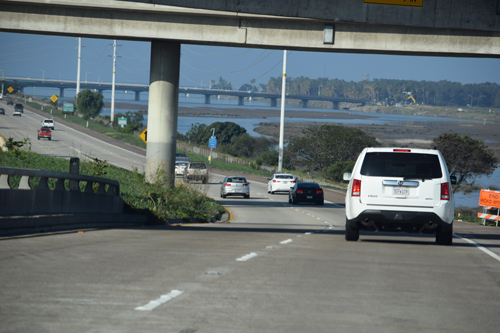
Interstate 8, Mile O — Nimitz Boulevard exit, Fort Rosecrans National Cemetery, Cabrillo National Monument, Cabrillo Elementary School
Story and travel photos by Donald H. Harrison
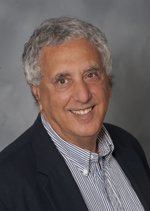
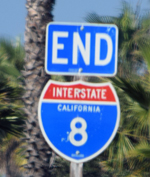
SAN DIEGO — Nimitz Boulevard at the western terminus of Interstate 8 is named for Fleet Admiral Chester Nimitz, who commanded the Pacific Fleet against the Japanese in World War II, and was the man who signed for the United States in the ceremony aboard the U.S.S. Missouri accepting the Japanese surrender.
Following the war, he was appointed by President Harry S. Truman as chief of naval operations (CNO), and in that position, he supported the proposal of then Captain, and later Admiral, Hyman Rickover, a Jewish officer, to convert the submarine fleet from diesel to nuclear power. Future U.S President Jimmy Carter, who served under Rickover, considered the admiral an inspiration and a mentor.
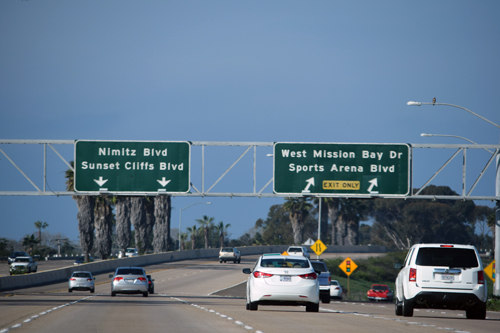
From Nimitz Boulevard, one may follow “Cabrillo National Monument” directional signs to navigate up the western side of the Point Loma Peninsula to the federal reservation on which the monument is located. Located above the junction of San Diego Bay and the Pacific Ocean, the monument celebrates the European discovery in 1542 of San Diego by the Portuguese explorer Juan Rodriguez Cabrillo, then in the employ of Spain. However, Rodriguez did not name this area “San Diego.”
As was the custom of Catholic explorers, he checked his calendar of feast days, and found that the one closest to the date of discovery — September 28th– was that of Saint Michael the Archangel. Accordingly, Cabrillo named the place “San Miguel.” The explorer died later on his voyage, and Sebastian Vizcaino, who “re-discovered” the area for Spain in 1602, named it “San Diego,” for a recently named saint so honored for medical miracles, including the saving of the life of a child of the King of Spain.
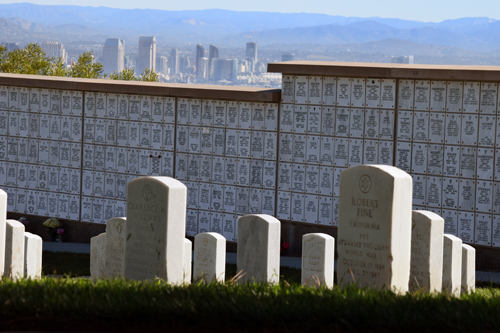
The Archangel Michael is honored in Judaism because in the Book of Daniel (10:13), Daniel has a vision of an unnamed angel who describes the Archangel Michael as “one of the foremost (heavenly) princes” and further (12:1-3) describes what Michael’s role will be at the End of Days. In a way, it is too bad that “San Diego” didn’t stay named “San Miguel,” because the angel’s description of the End of Days might have taken on far more immediacy at Fort Rosecrans National Cemetery, through which one passes en route to Cabrillo National Monument.
12:1 At that time Michael will stand, the great (heavenly) prince who stands in support of the members of your people, and there will be a time of trouble such as there had never been since there was a nation until that time. But at that time your people will escape; everything that is found written in this book (will occur). 12:2 Many of those who sleep in the dusty earth will awaken: these for everlasting life and these for shame, for everlasting abhorrence. 12:3 The wise will shine like the radiance of the firmament, and those who teach righteousness to the multitudes (will shine) like the stars, forever and ever.
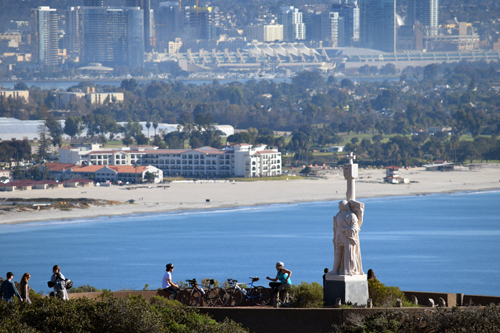
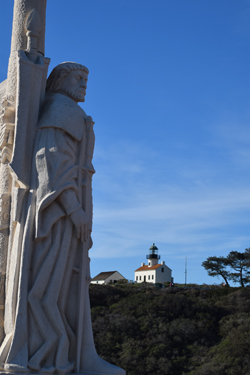
One of the features of the Cabrillo National Monument is a lighthouse that was built in 1855, more than 300 years after Cabrillo’s voyage of discovery. The original lighhouse keeper was named Robert Israel and because of his surname, curators of the small museum at the lighthouse once thought that he might be Jewish. They even put a tallit, long since removed, in one of the rooms. Genealogical records showed that notwithstanding his Hebraic-sounding name and possible Jewish ancestors somewhere in his father’s line, Israel was a Christian whose father was Pennsylvania Dutch and mother was Scotch-Irish. When he was married in 1852 to Maria Arcadia Alipas, a priest officiated at the ceremony. Among Israel’s four children was Robert Decatur Israel, whose burial service in 1908 was officated by an Episcopal Priest. The younger Israel’s stone is marked with a Christian cross at Fort Rosecrans National Cemetery.
On the uniform gravestones spread across hillsides overlooking the Pacific Ocean and San Diego Bay, there are markings of various religions, depending on the preference expressed by the deceased’s written request, or that of his survivors. Throughout the cemetery one can find Stars of David on the gravestones of Jewish personnel, such as that of Robert Fine, shown above.
Retracing one’s drive through the federal installation atop Pt. Loma, one soon comes to Talbot Street, which heads east toward San Diego Bay. Turn right, and just before where that street intersects with Rosecrans Avenue (named for U.S. Civil War General William Rosecrans) stands Cabrillo Elementary School, which has some interesting connections to San Diego’s early Jewish history.
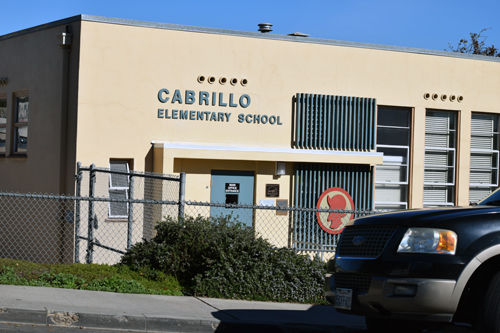
Just north of Talbot Avenue lies Roseville, a 30-block portion of the Point Loma community that was founded in 1869 by San Diego’s first Jewish settler Louis Rose. In 1895, seven years after Louis Rose’s death, his daughter Henrietta was appointed by the San Diego School Board as the first teacher at Roseville Elementary School, a position she kept for a year before being transferred to the Middletown Elementary School. Too small to accommodate Pt. Loma’s growing population, Roseville Elementary School eventually was torn down and replaced by Cabrillo Elementary School.
The school’s geographic and genealogical connections to Louis Rose led to the creation of a Sister School relationship between Cabrillo Elementary School and the Grundschule in Neuhaus-an-der-Oste, Germany, where Louis Rose grew up. Coincidentally, both schools serve pupils in kindergarten through 4th grade, and both schools are in communities built in the vicinity of ocean-going vessels. Students have exchanged letters and drawings, and teachers and administrators of the two schools have exchanged visits.
To return to Interstate 8, one may continue to the first street beyond the school, which is Rosecrans Avenue, and turn left. Follow Rosecrans Avenue several miles to where it branches into the entrances of Interstate 8 East and Interstate 5 North.
Next in the I-8 series: Mile 1, The Bahia Hotel
Harrison is editor of San Diego Jewish World. You may comment to him at donald.harrison@sdjewishworld.com, or post your comment on this website provided that the rules below are observed.
*
__________________________________________________________________
Care to comment? We require the following information on any letter for publication: 1) Your full name 2) Your city and state (or country) of residence. Letters lacking such information will be automatically deleted. San Diego Jewish World is intended as a forum for the entire Jewish community, whatever your political leanings. Letters may be posted below provided they are responsive to the article that prompted them, and civil in their tone. Ad hominem attacks against any religion, country, gender, race, sexual orientation, or physical disability will not be considered for publication. There is a limit of one letter per writer on any given day.
__________________________________________________________________